Jan Svoboda. Magnetic Techniques for the Treatment of Materials
Подождите немного. Документ загружается.

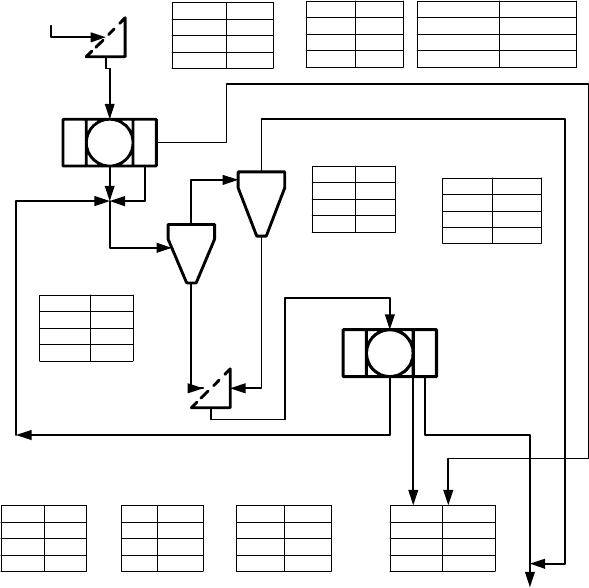
480 CHAPTER 6. INDUSTRIAL APPLICATIONS
Fe Fe3O4
Mass rec.
Fe Rec.
% solids <25 um
t/h New t/h
From screw classifier
Rougher
WHIMS
48.7 2.0
100 100
44.8 33.8
300 300
Legend
40.1 0.35
- -
32.8 32.4
- -
49.1 0.40
5.0 5.1
7.1 93.5
- -
39.7 0.34
- -
37.1 29.2
229 178
Feed MS II
34.0 0.30
- -
- 30
42 -
Middling MS II
23.4 0.25
43.1 20.7
- 22.0
104 -
Tailings
65.4 0.53
25.9 34.8
- 40.3
62 62
Concentrate II
66.1 3.6
51.9 70.5
- 37.8
69 69
Final concentrate
Feed cyclone 1
Overflow cyclone 2
Final tailings
Scavenger WHIMS
Feed MS 1
66.8 6.7
26.0 35.7
- 35.3
78 78
MS 1 conc.
Figure 6.13: Flowsheet of a two-stage WHIMS circuit at Fabrica Mine, Brazil
(adapted from [H24]).
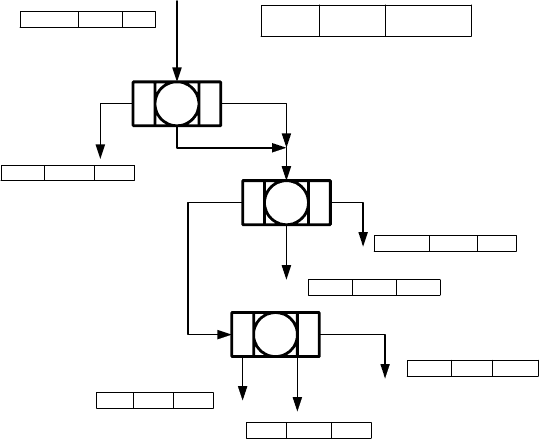
6.1. TREATMENT OF MINERALS 481
Grade
[%Fe]
Mass rec.
[%]
Recovery
[%Fe]
65.00 - -
Feed
Mags
67.90 50.52 52.73
Non-mags
Middl.
Mags
Middl.
56.60 16.50 14.35
59.60 5.65 5.18
66.72 17.44 17.88
65.60 3.81 3.84
64.45 6.08 6.02
Non-mags
Middl.
Mags
WHIMS 1
WHIMS 2
WHIMS 3
Non-mags
Legend
Figure 6.14: Flowesheet of the BHP (Australia) three-stage WHIMS plant for
the beneficiation of hematite ore (adapted from [H25]).
BHP, Australia
A three-stage Jones WHIMS separation circuit, shown in Fig. 6.14, beneficiates
hematite ore at the rate of 190 t/h at one of the BHP plants in Australia
[H25]. The grade of the feed into the circuit is approximately 63% Fe and 8%
SiO
2
+Al
2
O
3
. The grade of the final product from the circuit, at a recovery of
71% Fe, is 67.7% Fe and the content of SiO
2
+Al
2
O
3
is less than 2%.
At another BHP Iron Ore (Goldsworthy) plant, three Reading WHIMS ma-
chines have been used to recover iron from - 100 m hematite ore [M29]. The
upgrading of the feed (50.5% Fe, 19.7% SiO
2
and 4.80% Al
2
O
3
) is achieved by
rejection of silica and alumina into the tailings. At an overall recovery of 73.7%
Fe the grade of the final concentrate amounts to 61.5% Fe, 6.2% SiO
2
and 2.09%
Al
2
O
3
. The flowsheet of the process is shown in Fig. 6.15.
The application of SLON WHIMS to the beneficiation of iron ores in
China
The first SLON wet high-intensity magnetic separator was developed in 1988
and since its introduction into the market it has been successfully installed at
numerous mineral processing plants in China. At present SLON separators of
various sizes are operating at more than 30 beneficiation plants.

482 CHAPTER 6. INDUSTRIAL APPLICATIONS
Surge tank
WHIMS 2
WHIMS1
Non-mags
Non-mags
Mags
Scavenger
WHIMS
Non-mags
To
thickener
Belt filter
Hematite product
Reject
Mags - to
belt filter
Reject
Screen
Screen
U/S
U/S
U/F
O/F
Feed
LIMS
O/F
U/F
Mags
O/F
U/F
Cyclone
P-14
P-17
P-18
Figure 6.15: Flowsheet of the Reading WHIMS circuit at the BHP Iron Ore
(Goldsworthy) Plant (adapted from [M29]).
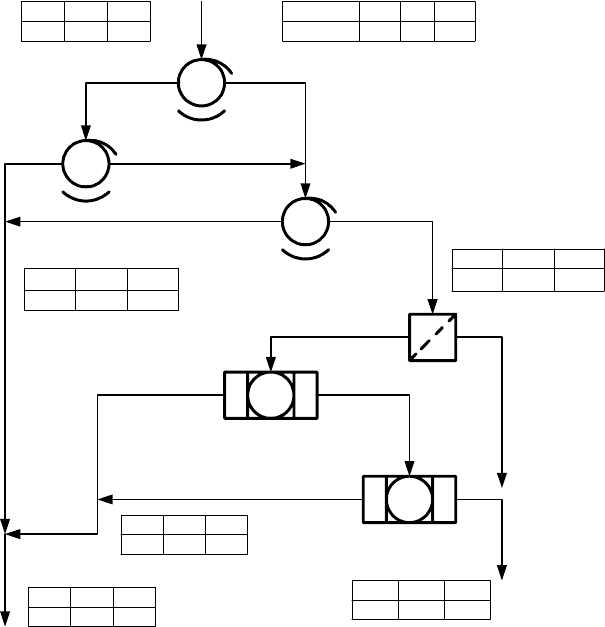
6.1. TREATMENT OF MINERALS 483
Grade %Fe %S %P
Recovery %Fe %S %P
Legend
52.77 0.44 0.399
100 100 100
Feed
LIMS rougher
LIMS
scavenger
LIMS
cleaner
magnetite
42.46 0.68 0.614
44.89
86.88
85.92
Dewatering
65.78 0.13
0.127
55.11 13.12 14.08
SLON rougher
SLON scavenger
Water
Tailings
26.13 1.61 1.626
5.49 40.90 45.24
46.52 0.45 0.363
39.4045.9840.68
56.08 0.29 0.246
94.5159.1054.76
Final concentrate
Flotation
concentrate
Figure 6.16: Flowsheet of the magnetic separation circuit at the Meishan Iron
Ore Mine, China (adapted from [X4]).
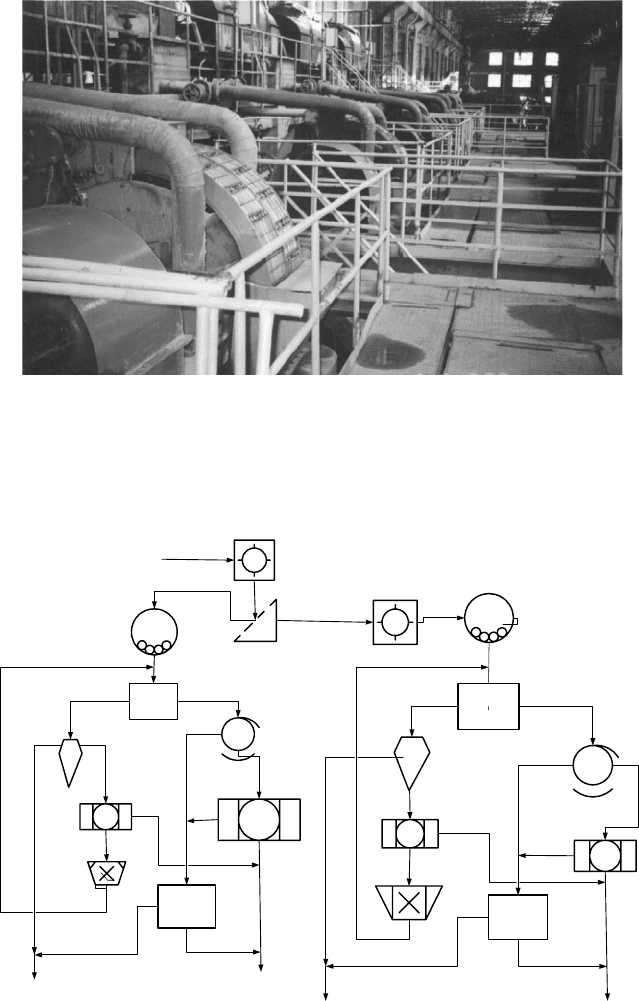
484 CHAPTER 6. INDUSTRIAL APPLICATIONS
Figure 6.17: SLON-1500 separators operating in Meishan Iron Ore Plant (cour-
tesy of the Ganzhou Non-ferrous Metallurgy Research Institute,
China).
Reverse
flotation
Classi-
fication
Reverse
flotation
Feed
Crushing
Screening
Crushing
Grinding
Grinding
Classification
LIMS
Spiral
HIMS
SLON
Grinding
Mags
Concentrate
Tailings
Tailings
Non-mags
Coarse
Fine, - 75 um
Non-mags
Iron concentrate
HIMS
Mags
Grinding
Non-mags
LIMS
SLON
Mags
Non-mags
Tailings
Mags
Spiral
- 20 mm
-75 + 20
mm
Coarse
Fine, - 75 um
Figure 6.18: Flowsheet of the Qi Dashan Iron Ore Processing Plant, China
(adapted from [X5]).
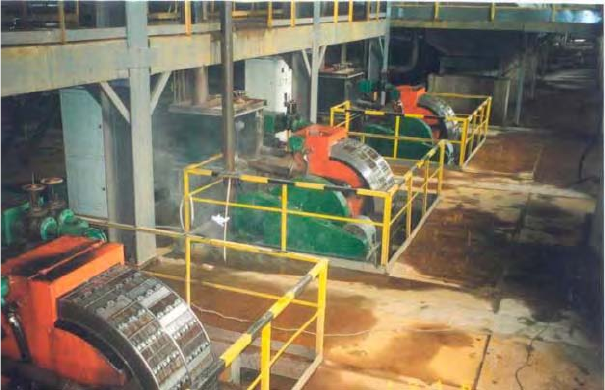
6.1. TREATMENT OF MINERALS 485
Figure 6.19: SLON 1750 wet high-intensity magnetic separators operating at the
Qi Dashan Beneficiation Plant, China (courtesy of Xiong Da-he).
Meishan Iron Ore Mine, China Meishan Iron Ore Mine processes 4 mil-
lion tonnes of iron ore and produces about 2.6 million tonnes of iron concentrate
annually. Because of a relatively high content of phosphorus, the iron concen-
trate did not meet market requirements. In recent years 18 SLON Model 1500
WHIMS machines have been applied to reduce the concentration of phospho-
rus. The Meishan Mine circuit is the largest application of SLON separators in
China.
In the flowsheet shown in Fig. 6.16, the iron concentrate from sulphide
flotation (70% - 75 m) is first exposed to low-intensity magnetic separators to
remove magnetite. SLON 1500 machines, shown in Fig. 6.17, are then used as
roughers and scavengers to recover hematite and siderite.
Qi Dashan Mineral Processing Plant, China Qi Dashan Mineral Process-
ing Plant in Liao Ning Province, China, processes 8 million tonnes of low-grade
iron ore per annum. Hematite, magnetite and limonite are the main iron min-
erals. The original beneficiation process for the coarse fraction (- 75 + 20 mm)
was based on roasting, grinding and low-intensity magnetic separation. Since
the final concentrate could not meet the metallurgical requirement of 67% Fe,
the flowsheet was re-designed and six SLON separators Model 1750 were im-
plemented, as is shown in Fig. 6.18. Figure 6.19 depicts SLON separators in
operation.
In the new flowsheet the ore is ground to 60% - 75mandclassifiedina
hydrocyclone. While the underflow is treated by spirals, the overflow is upgraded
by LIMS, SLON WHIMS and flotation. Compared to the original roast-LIMS
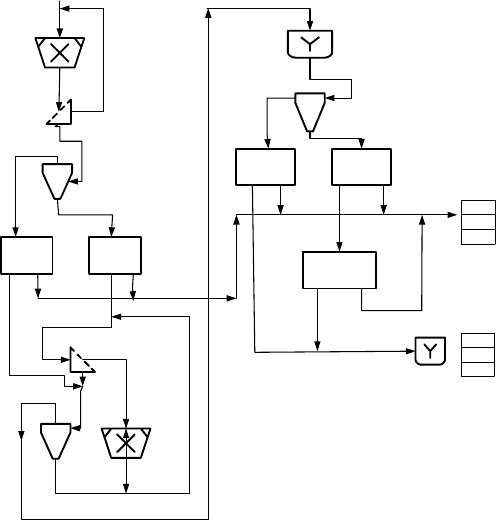
486 CHAPTER 6. INDUSTRIAL APPLICATIONS
Mag
Sep
Mag
sep
Mag
Sep
Mag
Sep
Mag Sep
Feed -20 mm
Grind 1
70% -74 um
O/F
U/F
Mags
Non-mags
Grind 2
95% - 45 um
Thickener
U/F
O/F
Mags
Non-mags
Mags
Non-mags
Mags
Non-mags
Thickener
Filtration
37.1
63.0
65.0
Concentrate
62.9
20.0
35.0
Tailings
Mags Non-mags
Figure 6.20: Flowsheet of the KGOKOR (the Ukraine) Iron Ore Beneficiation
plant (adapted from [M33]).
flowsheet the grade of the concentrate is higher by 3.6% and the recovery of iron
is higher by 5.6% [X5].
Beneficiation of iron ore in Krivoy Rog, the Ukraine
Oxidized ferruginous quartzites of deposits in the Krivoy Rog Basin consist
mainly of magnetite (4.5%), hematite and martite (38.4%), iron hydroxides
(9.5%) and quartz (44.9%). The mineral grains are liberated at - 45 m, al-
though hematite is liberated at - 15 m. Various beneficiation methods were in-
vestigated when the Krivoy Rog Mining and Beneficiation Complex (KGOKOR)
was designed [M33, M34,U3]. The ultimate flowsheet includes 11 sections, each
having a capacity of 2.4 Mt of ore per annum. High-intensity three-rotor separa-
tors 6-ERM 35/315 with grooved plate matrix form the core of the beneficiation
circuit [M33]. Throughput of the separator is 100 t/h, rotor diameter 3150 mm,
magnetic induction 1.35 T and the gaps between the grooved plates 4 mm. The
non-magnetic fractions from the top rotor are re-cleaned in the middle and lower
rotors. The flowsheet of the KGOKOR beneficiation plant is shown in Fig. 6.20
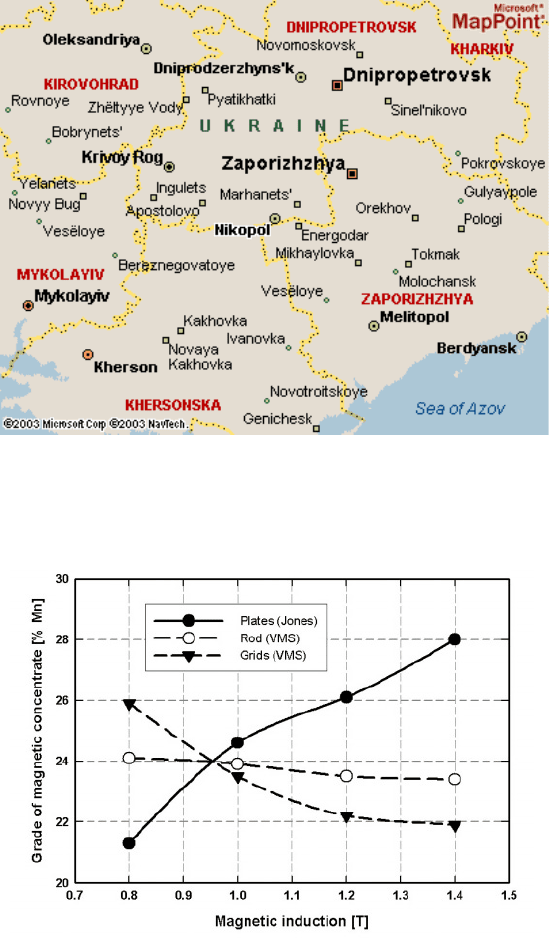
6.1. TREATMENT OF MINERALS 487
Figure 6.21: Geographical positions of the Krivoy Rog, Nikopol and Marganets
(the Ukraine) iron and manganese ore deposits.
Figure 6.22: The grade of the magnetic concentrate from the Ordzhonikidze
Basin manganese slimes, as a function of the magnetic field
strength, as obtained with Jones and VMS separators (adapted
from [V9]).
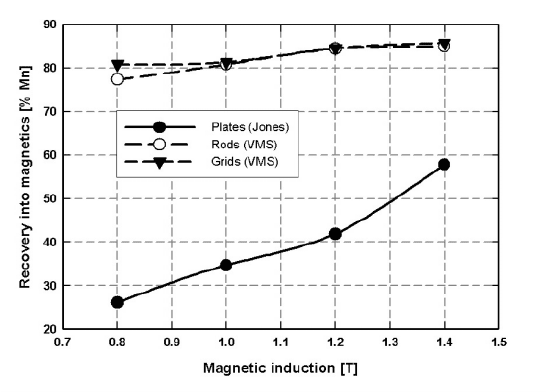
488 CHAPTER 6. INDUSTRIAL APPLICATIONS
Figure 6.23: The recovery of manganese into the magnetic concentrate of the
Ordzhonikidze Basin slimes, as a function of the magnetic field
strength, obtained with Jones and VMS separators (adapted from
[V9]).
and the geographical location of the plant in Fig. 6.21.
Treatment of tailings from the Krivoy Rog GOK The Krivoy Rog bene-
ficiation plant generates more than 60 million cubic meters of tailings annually.
By employing wet high-intensity magnetic separation iron-rich and iron-poor
products are obtained. These products are then used in the building industry:
the iron-rich fraction, containing up to 38% Fe is used as a correction component
in the production of portland cement clinker, while the non-magnetic fraction
with an iron concentration of 7% is used for the manufacture of bricks [K27].
6.1.4 Beneficiation of manganese ores
The exhaustion of high-grade oxide manganese ores and gradual introduction
of the increasing volumes of low-grade oxide and carbonate manganese ores
into the beneficiation process result in the reduction of the e!ciency of their
upgrading. In addition, during the beneficiation process, large quantities of
tailings are generated, with manganese minerals usually smaller than 20 m.
The slimes are the main source of losses of manganese.
Extensive research at the Mekhanobrchermet Institute (the Ukraine) demon-
strated wet high-intensity magnetic separation as a promising method of increas-
ing the e!ciency of beneficiation of refractory manganese ores and their slimes
from the Nikopol basin in the Ukraine. Laboratory and pilot-scale tests were
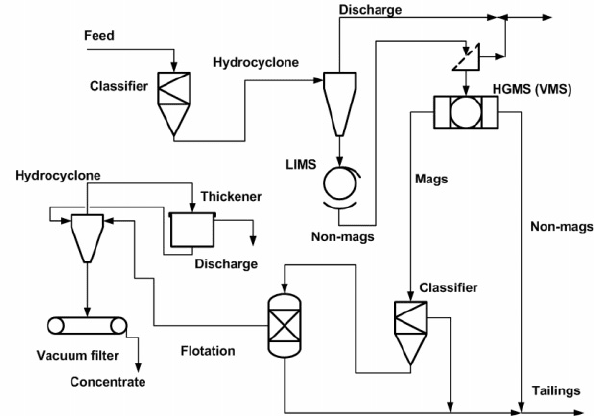
6.1. TREATMENT OF MINERALS 489
Figure 6.24: Flowsheet of the Chkalovsky manganese ore beneficiation plant,
the Ukraine (adapted from [V9]).
conducted using Jones WHIMS with the plate matrix and VMS high-gradient
separator with rod and grid matrices. The results of the tests are summarized in
Figs. 6.22 and 6.23. The results confirm that the VMS separator equipped with
rod and grid matrices produced the manganese concentrate with a considerably
higher recovery [V9].
The production-scale circuit for the treatment of the manganese slimes,
which included full-scale VMS 100/2 magnetic separators was installed in 1988
at the Tchkalov beneficiation plant of the Ordzhonikidze GOK in the Nikopol
Basin (the Ukraine) [L23, L24]. The geographical position of the basin is shown
in Fig. 6.21 and the flowsheet of the 400 kt per annum pilot plant at the
Tchkalov beneficiation plant is illustrated in Fig. 6.24. The VMS separator
installation at the Tchkalov plant is shown in Fig. 6.25. Two VMS magnetic
separators are also in operating at the Marganets plant.
6.1.5 Beneficiation of ilmenite ores
Pang Zhi Hua Processing Plant, China
The Pang Zhi Hua ilmenite processing plant is the biggest producer of ilmenite
in China. The deposit contains vanadium, titanium and iron minerals. The
processing plant recovers magnetite and vanadium and the tailings from the
iron recovery plant represent the feed into the ilmenite processing plant. In the
original process the coarse fraction (+ 45 m) of the ore was beneficiated using
